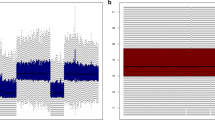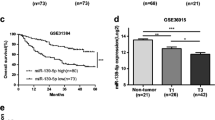Abstract
The high ratio of global mortality rate to incidence rate and steep increase in incidence of liver cancer warrants need for advancement of innovative cancer treatment and therapy for hepatocellular carcinoma (HCC). miRNAs are fascinating prospects as treatments in the form of miRNA mimics or therapeutic targets because of their capacity to target various mRNAs that are changed in diseased states. Micronome is a tool to find signature miRNA for any disease and there is hardly any study on micronome in HCC. The aim of the present study was to identify the genes involved in tumor growth and angiogenesis in HCC patients and determine the signature miRNA by constructing a micronome. Herein, we performed a comprehensive analysis on dysregulated genes obtained from liver cancer gene databases. Only experimentally validated miRNA of angiogenesis genes were included in the study. Micronome was constructed using Cytoscape software and search tools for the retrieval of interacting genes (STRING) database. Dysregulated genes of HCC were integrated with miRNAs for identification of signature miRNA involved and identify genes (acting as positive or negative regulator) to elucidate the potential regulatory pathway or signaling. The study clearly reflects that hsa-mir-205-5p is the signature miRNA for positively regulating angiogenesis in HCC through VEGFA. These regulatory genes and signature miRNAs may be useful to understand the unique angiogenesis process of HCC and quick development of novel/better and cost effective molecular-targeted treatment strategies in HCC as the responsible regulatory molecules can be pinpointed with limited resources with use of bioinformatics.







Similar content being viewed by others
References
Rawla, P., Sunkara, T., Muralidharan, P., & Raj, J. P. (2018). Update in global trends and aetiology of hepatocellular carcinoma. Contemporary Oncology, 22, 141–150.
Llovet, J. M., De Baere, T., Kulik, L., Haber, P. K., Greten, T. F., Meyer, T., & Lencioni, R. (2021). Locoregional therapies in the era of molecular and immune treatments for hepatocellular carcinoma. Nature Reviews Gastroenterology & Hepatology, 18, 293–313.
GLOBOCAN. (2020). Cancer Today. http://gco.iarc.fr/today/home
Gupta, M. K., & Qin, R.-Y. (2003). Mechanism and its regulation of tumor-induced angiogenesis. World Journal of Gastroenterology, 9, 1144–1155.
Karamysheva, A. F. (2008). Mechanisms of angiogenesis. Biochemistry Moscow, 73, 751–762.
Flier, J. S., Underhill, L. H., & Dvorak, H. F. (1986). Tumors: Wounds that do not heal. New England Journal of Medicine, 315, 1650–1659.
Kaseb, A. O., Hanbali, A., Cotant, M., Hassan, M. M., Wollner, I., & Philip, P. A. (2009). Vascular endothelial growth factor in the management of hepatocellular carcinoma: A review of literature. Cancer, 115, 4895–4906.
Rupaimoole, R., & Slack, F. J. (2017). MicroRNA therapeutics: Towards a new era for the management of cancer and other diseases. Nature Reviews Drug Discovery, 16, 203–222.
Bartel, D. P. (2004). MicroRNAs. Cell, 116, 281–297.
Lee, R. C., Feinbaum, R. L., & Ambros, V. (1993). The C. elegans heterochronic gene lin-4 encodes small RNAs with antisense complementarity to lin-14. Cell, 75, 843–854.
Reinhart, B. J., Slack, F. J., Basson, M., Pasquinelli, A. E., Bettinger, J. C., Rougvie, A. E., Horvitz, H. R., & Ruvkun, G. (2000). The 21-nucleotide let-7 RNA regulates developmental timing in Caenorhabditis elegans. Nature, 403, 901–906.
Iorio, M. V., & Croce, C. M. (2012). Causes and consequences of microRNA dysregulation. Cancer Journal, 18, 215–222.
Hanahan, D., & Weinberg, R. A. (2011). Hallmarks of cancer: The next generation. Cell, 144, 646–674.
Peng, Y., & Croce, C. M. (2016). The role of microRNAs in human cancer. Signal Transduction and Targeted Therapy, 1, 15004.
Lian, Q., Wang, S., Zhang, G., Wang, D., Luo, G., Tang, J., Chen, L., & Gu, J. (2018). HCCDB: A database of hepatocellular carcinoma expression atlas. Genomics, Proteomics & Bioinformatics, 16, 269–275.
Hsu, C.-N., Lai, J.-M., Liu, C.-H., et al. (2007). Detection of the inferred interaction network in hepatocellular carcinoma from EHCO (encyclopedia of hepatocellular carcinoma genes online). BMC Bioinformatics, 8, 66.
Kaur, H., Bhalla, S., Kaur, D., & Raghava, G. P. (2020). CancerLivER: A database of liver cancer gene expression resources and biomarkers. Database, 2020, 011.
Ouyang J, Sun Y, Li W, Zhang W, Wang D, Liu X, Lin Y, Lian B, Xie L (2016). A dbPHCC: a database of prognostic biomarkers for hepatocellular carcinoma that provides online prognostic modeling. Biochimica et Biophysica Acta 180: 2688-2695
Szklarczyk, D., Gable, A. L., Lyon, D., et al. (2019). STRING v11: Protein–protein association networks with increased coverage, supporting functional discovery in genome-wide experimental datasets. Nucleic Acids Research, 47, D607–D613.
Huang, H.-Y., Lin, Y.-C.-D., Li, J., et al. (2019). miRTarBase 2020: Updates to the experimentally validated microRNA–target interaction database. Nucleic Acids Research, 1, 896.
Karagkouni, D., Paraskevopoulou, M. D., Chatzopoulos, S., et al. (2018). DIANA-TarBase v8: A decade-long collection of experimentally supported miRNA–gene interactions. Nucleic Acids Research, 46, D239–D245.
Xiao, F., Zuo, Z., Cai, G., Kang, S., Gao, X., & Li, T. (2009). miRecords: An integrated resource for microRNA-target interactions. Nucleic Acids Research, 37, D105–D110.
Jiang, Q., Wang, Y., Hao, Y., Juan, L., Teng, M., Zhang, X., Li, M., Wang, G., & Liu, Y. (2009). miR2Disease: A manually curated database for microRNA deregulation in human disease. Nucleic Acids Research, 37, D98–D104.
Oulas, A., Karathanasis, N., Louloupi, A., & Poirazi, P. (2011). Finding cancer-associated miRNAs: Methods and tools. Molecular Biotechnology, 49, 97–107.
Lombe, C. P., Meyer, M., & Pretorius, A. (2022). Bioinformatics prediction and analysis of MicroRNAs and their targets as biomarkers for prostate cancer: A preliminary study. Molecular Biotechnology, 64, 401–412.
Betel, D., Wilson, M., Gabow, A., Marks, D. S., & Sander, C. (2007). The microRNA.org resource: Targets and expression. Nucleic Acids Research, 36, D149–D153.
Agarwal V, Bell GW, Nam J-W, Bartel DP (2015) Predicting effective microRNA target sites in mammalian mRNAs. ELife 4:e05005
Shannon, P., Markiel, A., Ozier, O., Baliga, N. S., Wang, J. T., Ramage, D., Amin, N., Schwikowski, B., & Ideker, T. (2003). Cytoscape: A software environment for integrated models of biomolecular interaction networks. Genome Research, 13, 2498–2504.
Shirdel, E. A., Xie, W., Mak, T. W., & Jurisica, I. (2011). NAViGaTing the micronome: Using multiple MicroRNA prediction databases to identify signalling pathway-associated microRNAs. PLoS ONE, 6, e17429.
Nishida, N., Yano, H., Nishida, T., Kamura, T., & Kojiro, M. (2006). Angiogenesis in cancer. Vascular Health and Risk Management, 2, 213–219.
Gu, C., Lhamo, T., Zou, C., Zhou, C., Su, T., Draga, D., Luo, D., Zheng, Z., Yin, L., & Qiu, Q. (2020). Comprehensive analysis of angiogenesis-related genes and pathways in early diabetic retinopathy. BMC Medical Genomics, 13, 142.
Li, Z., Lin, Y., Cheng, B., Zhang, Q., & Cai, Y. (2021). Identification and analysis of potential key genes associated with hepatocellular carcinoma based on integrated bioinformatics methods. Frontiers in Genetics, 12, 571231.
Gao, Y., Liu, J., Zhao, D., & Diao, G. (2022). A novel prognostic model for identifying the risk of hepatocellular carcinoma based on angiogenesis factors. Frontiers in Genetics, 13, 857215.
Beheshtizadeh, N., Asgari, Y., Nasiri, N., Farzin, A., Ghorbani, M., Lotfibakhshaiesh, N., & Azami, M. (2021). A network analysis of angiogenesis/osteogenesis-related growth factors in bone tissue engineering based on in-vitro and in-vivo data: A systems biology approach. Tissue and Cell, 72, 101553.
Hozhabri, H., Ghasemi Dehkohneh, R. S., Razavi, S. M., et al. (2022). Comparative analysis of protein–protein interaction networks in metastatic breast cancer. PLoS ONE, 17, e0260584.
Shaji, S. K., Drishya, G., Sunilkumar, D., Suravajhala, P., Kumar, G. B., & Nair, B. G. (2022). Systematic understanding of anti-tumor mechanisms of Tamarixetin through network and experimental analyses. Science and Reports, 12, 3966.
Liu, J., Wang, J., Fu, W., et al. (2021). MiR-195-5p and miR-205-5p in extracellular vesicles isolated from diabetic foot ulcer wound fluid decrease angiogenesis by inhibiting VEGFA expression. Aging, 13, 19805–19821.
Ferrari, E., & Gandellini, P. (2020). Unveiling the ups and downs of miR-205 in physiology and cancer: Transcriptional and post-transcriptional mechanisms. Cell Death & Disease, 11, 980.
Yang, W., Tan, S., Yang, L., et al. (2022). Exosomal miR-205-5p enhances angiogenesis and nasopharyngeal carcinoma metastasis by targeting desmocollin-2. Molecular Therapy Oncolytics, 24, 612–623.
Zhang, G.-F., Wu, J.-C., Wang, H.-Y., Jiang, W.-D., & Qiu, L. (2020). Overexpression of microRNA-205-5p exerts suppressive effects on stem cell drug resistance in gallbladder cancer by down-regulating PRKCE. Bioscience Reports, 40, 20194509.
Liu, X., Chen, D., Chen, H., et al. (2021). YB1 regulates miR-205/200b-ZEB1 axis by inhibiting microRNA maturation in hepatocellular carcinoma. Cancer Communications, 41, 576–595.
Zhao, X., Zhou, S., Wang, D., He, W., Li, J., & Zhang, S. (2018). MicroRNA-205 is downregulated in hepatocellular carcinoma and inhibits cell growth and metastasis via directly targeting vascular endothelial growth factor A. Oncology Letters, 16, 2207–2214.
Dat, V. H. X., Nhung, B. T. H., Chau, N. N. B., Cuong, P. H., Hieu, V. D., Linh, N. T. M., & Quoc, N. B. (2022). Identification of potential microRNA groups for the diagnosis of hepatocellular carcinoma (HCC) using microarray datasets and bioinformatics tools. Heliyon, 8, e08987.
Zhong, G., & Xiong, X. (2015). miR-205 promotes proliferation and invasion of laryngeal squamous cell carcinoma by suppressing CDK2AP1 expression. Biological Research, 48, 60.
Borel, F., Konstantinova, P., & Jansen, P. L. M. (2012). Diagnostic and therapeutic potential of miRNA signatures in patients with hepatocellular carcinoma. Journal of Hepatology, 56, 1371–1383.
Ruiz-Manriquez, L. M., Carrasco-Morales, O., Sanchez, Z. E. A., Osorio-Perez, S. M., Estrada-Meza, C., Pathak, S., Banerjee, A., Bandyopadhyay, A., Duttaroy, A. K., & Paul, S. (2022). MicroRNA-mediated regulation of key signaling pathways in hepatocellular carcinoma: A mechanistic insight. Frontiers in Genetics, 13, 910733.
Zhang, J., Zhang, J., Pang, X., et al. (2021). MiR-205-5p suppresses angiogenesis in gastric cancer by downregulating the expression of VEGFA and FGF1. Experimental Cell Research, 404, 112579.
Author information
Authors and Affiliations
Contributions
All the authors have contributed to the study conception and design. Methodology: AUT, PB; Analysis and investigation: AUT, PB. Writing-original draft preparation: AUT; Writing-review and editing: SKS, PB; Supervision: SKS, PB.
Corresponding author
Ethics declarations
Conflict of interest
The authors declare that they have no conflict of interest.
Additional information
Publisher's Note
Springer Nature remains neutral with regard to jurisdictional claims in published maps and institutional affiliations.
Supplementary Information
Below is the link to the electronic supplementary material.
Rights and permissions
Springer Nature or its licensor (e.g. a society or other partner) holds exclusive rights to this article under a publishing agreement with the author(s) or other rightsholder(s); author self-archiving of the accepted manuscript version of this article is solely governed by the terms of such publishing agreement and applicable law.
About this article
Cite this article
Toro, A.U., Shukla, S.K. & Bansal, P. Micronome Revealed miR-205-5p as Key Regulator of VEGFA During Cancer Related Angiogenesis in Hepatocellular Carcinoma. Mol Biotechnol 65, 1178–1186 (2023). https://doi.org/10.1007/s12033-022-00619-5
Received:
Accepted:
Published:
Issue Date:
DOI: https://doi.org/10.1007/s12033-022-00619-5




